Islamic State leader Abu Bakr al-Baghdadi dead: Donald Trump reveals details
Donald Trump reveals how Abu Bakr al-Baghdadi ‘whimpered’ as special forces chased him down.
President Donald Trump on Sunday said that elusive Islamic State leader Abu Bakr al-Baghdadi had been killed, dying “like a dog,” in a daring, night-time raid by US special forces deep in northwest Syria.
President Trump told the nation in a televised address from the White House that US forces killed a “large number” of Islamic State militants during the airborne raid in Idlib province, which culminated in cornering Baghdadi in a tunnel, where he set off a suicide vest.
“He ignited his vest, killing himself,” President Trump said.
“He died after running into a dead end tunnel, whimpering and crying and screaming all the way,” President Trump said, adding that three of Baghdadi’s children also died in the blast.
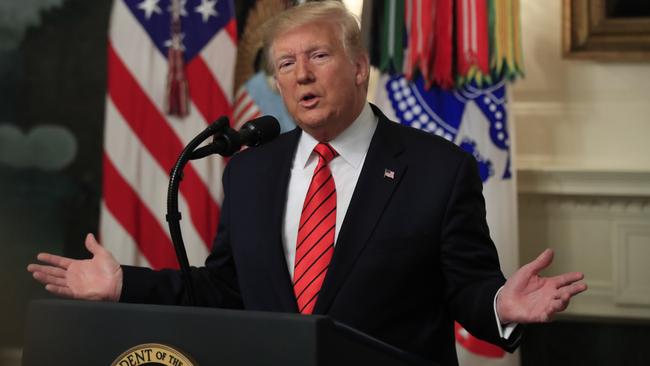
Mr Trump said the raid — which required eight military helicopters flying more than an hour from an undisclosed base over territory controlled by Russian and Syrian forces, had been accomplished by help from Russia, Syria, Turkey and Iraq. Mr Trump also thanked Kurdish fighters in Syria for their support.
Special forces “executed a dangerous and daring nightime raid in northwestern Syria and accomplished their mission in grand style,” he said.
MORE: Two raids, two very different presidents | Iraq led CIA to Baghdadi
Mr Trump spoke in graphic detail for 48 minutes about the raid, describing how he watched from the Situation Room in the White House as “brilliant fighters” from US Special Forces landed outside the village of Barisha, before running from the helicopters and blasting through the walls of the village compound where Baghdadi was staying with his family.
It was “as though we were watching a movie”, he said.
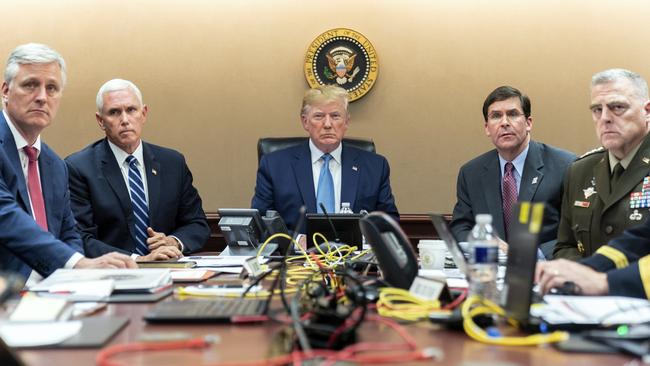
He said special forces breached the walls of the building because the doors were booby-trapped.
“The thug who tried so hard to intimidate others spent his last moments in utter fear, panic and dread, terrified of the American forces coming down on him,” Mr Trump said.
“He reached the end of the tunnel as our dogs chased him down. He ignited his vest, killing himself and his three children. His body was mutilated by the blasts. The tunnel had caved on him … He died after running into a dead-end tunnel, whimpering and crying and screaming”.
After al-Baghdadi’s death US forces spent around two hours in the compound, taking away “sensitive information” about Islamic State said Mr Trump,
He claimed no Americans were injured, but Defence Secretary Mark Esper said two service members suffered minor injuries, although they had already returned to duty. One of the dogs chasing al-Baghdadi was seriously wounded when the terror leader exploded his suicide vest.
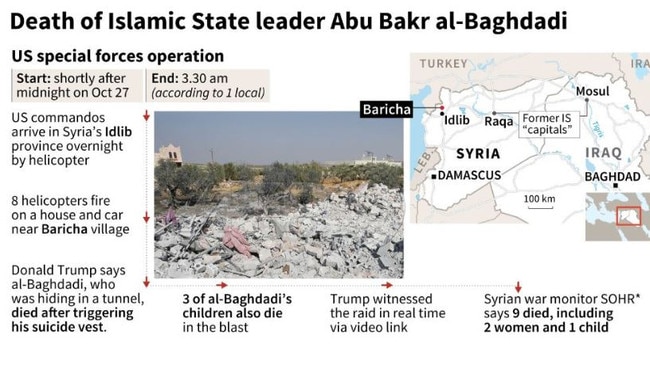
Mr Esper told CNN that plan had been to capture al-Baghdadi alive if possible but to kill him if necessary.
“We tried to call out and ask him to surrender himself,” he told CNN. “He refused and went down into a subterranean area and in the process of trying to get him out, he detonated a suicide vest, we believe, and killed himself”.
Planning for the operation began two weeks ago, Mr Trump said, after the US gained unspecified intelligence on al-Baghdadi’s whereabouts. The President approved the operation on Saturday morning after receiving “actionable intelligence,” Vice President Mike Pence told CBS.
Mr Esper added: “The president … chose the option that we thought gave us the highest probability of success.”
Mr Trump suggested he might order the release of the video so the world knows al-Baghdadi did not die of a hero and spent his final moments “crying, “whimpering” and “screaming.”
According to local witnesses, the operation killed nine people outside the village of Barisha in Idlib.
The Syrian Observatory for Human Rights said an attack happened near to “groups linked to the Islamic State group”.
A witness in Barisha said he heard helicopters around midnight, followed by what he described as coalition air strikes.
Eight helicopters targeted Islamic State positions with heavy strikes for about two hours, during which time jihadists fired back with heavy weapons. They “were flying very low, causing great panic among the people”, Ahmed Hassawi said.
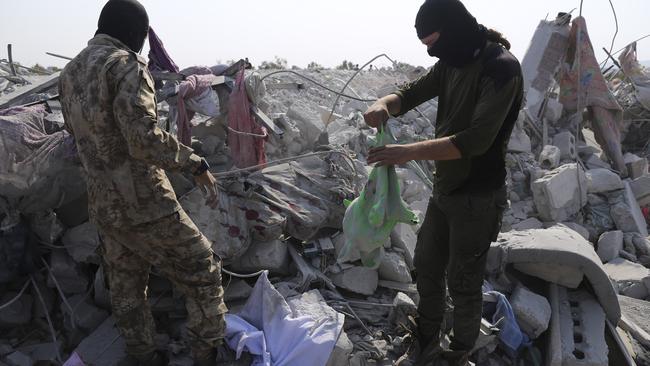
Morrison: Death significant blow to ISIS
Scott Morrison welcomed al-Baghdadi’s death, describing it as a “significant blow to ISIS” and another step in preventing the terrorist organisation’s revitalisation.
But in a joint statement with Foreign Minister Marise Payne and Defence Minister Linda Reynolds on Monday, the Prime Minister warned that ISIS still presented a security threat and Australian Defence Force personnel would continue to support Coalition operations against ISIS.
“The announcement by US President Donald Trump confirming the death of ISIS leader Abu Bakr al-Baghdadi is welcomed by Australia,” they said in a statement. “Al-Baghdadi died in a US-led raid on his hideout in northwest Syria on 26 October.
“He led a murderous, terrorist group responsible for widespread misery and destruction across large parts of Iraq and Syria.
“He also inspired or directed cowardly attacks by ISIS followers against innocent civilians around the world, some of whom were Australian. He was responsible for ordering ethnic cleansing, sexual slavery, and other crimes against humanity.”
Mr Morrison said it was important to remember the raid does “not represent the end of the campaign to defeat this terrorist group and the extremism it embodies.”
“...Australia remains an active contributor to the 79-member Global Coalition to Defeat ISIS, and is committed to playing our part in the evolving counter-terrorism fight,” Mr Morrison said. “Keeping Australians safe from terrorist attacks remains a foremost priority for the Government.”
Caliphate of brutality
At its height, Islamic State controlled swaths of Iraq and Syria in a self-declared state known as a caliphate, characterised by the brutal imposition of a puritanical version of Islam.
In addition to oppressing the people it governed, Islamic State planned or inspired terrorism attacks across Europe, while using expertise in social media to lure large numbers of foreign volunteers.
It took years of war, in which Islamic State became notorious for mass executions and sickening hostage murders, before the caliphate’s final slice of territory in Syria was seized this March.
The death of Baghdadi comes as a big boost for President Trump, whose abrupt decision to withdraw a small but effective deployment of US forces from Syria caused fears that it would give Islamic State remnants and sleeper cells a chance to regroup.
Trump took a storm of criticism, including from his own usually loyal Republican Party.
In keeping with his liking for showmanship, Trump had teased the news late Saturday with an enigmatic tweet saying merely that “Something very big has just happened!”
Baghdadi ‘killed’ many times
US experts are using biometric analysis to confirm the identities of those killed in the raid, which occurred in Idlib, in northwestern Syria.
Baghdadi, 48, had a $US25m bounty on his head and had previously been reported killed in 2012, 2014 and 2015 in various US-led bombing raids in Syria.
While many of Baghdadi’s henchmen had been killed in air strikes, there was uncertainty about the cleric leader’s fate until Islamic State published a video message from him in April, where he exhorted further uprisings against the West.
Something very big has just happened!
— Donald J. Trump (@realDonaldTrump) October 27, 2019
His elusiveness, secrecy and ability to galvanise multiple terror attacks by jihadists inside Europe had earned him a nickname of the “shadowy one’’.
Baghdadi’s reported death comes as the US withdrawal from Syria and Turkey’s incursion into the northeastern areas of the country have created geopolitical turmoil in the region, including a resurgence of Islamic State.
Last month, a Baghdadi audio message called on supporters to free Islamic State women jailed in camps in Iraq and Syria, including the infamous al-Hawl camp where scores of Australians are living.
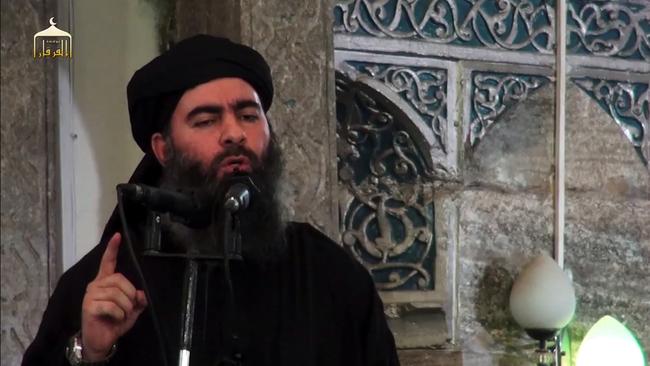
The death of Baghdadi will help quell strident criticism of Mr Trump’s Syrian strategy, first withdrawing troops on October 9, then reversing his decision to leave several hundred in the region.
On Sunday, the US announced it was sending armoured vehicles and combat troops into eastern Syria to protect Syria’s oilfields.
American media reported US special operations commandos had carried out a risky raid in northwestern Syria on Saturday.
Iran was informed by Syrian sources that Baghdadi had been killed, two Iranian officials told Reuters on Sunday.
“Iran was informed about Baghdadi’s death by Syrian officials who got it from the field,” one of the officials said.
Meanwhile, a deal between Turkey and Russia, with the Kurds turning to the Syrian government, has led to a complicated arrangement in northern Syria near the Turkish border.
The pullback of US troops raised a storm of bipartisan criticism in Washington that Islamic State could regain strength, after it had lost vast stretches of territory it had once controlled.
In the chaos of the Turkish incursion, hundreds of its supporters escaped from a Kurdish detention camp.
‘It’s a burden to be in charge of you’
In 2014, Baghdadi was a black-robed figure delivering a sermon from the pulpit of Mosul’s Great Mosque of al-Nuri, his only known public appearance. He urged Muslims around the world to swear allegiance to the caliphate and obey him as its leader.
“It is a burden to accept this responsibility to be in charge of you,” he said in the video. “I am not better than you or more virtuous than you. If you see me on the right path, help me. If you see me on the wrong path, advise me and halt me. And obey me as far as I obey God.” Though at minimum a symbolic victory for Western counter terrorism efforts, his death would have unknown practical impact on possible future attacks. He had been largely regarded as a symbolic figurehead of the global terror network, and was described as “irrelevant for a long time” by a coalition spokesman in 2017.
Al-Baghdadi was born Ibrahim Awwad Ibrahim Ali al-Badri al-Samarrai in 1971 in Samarra, Iraq, and adopted his nom de guerre early on. Because of anti-US militant activity, he was detained by US forces in Iraq and sent to Bucca prison in February 2004, according to IS-affiliated websites. He was released 10 months later, after which he joined the al-Qa'ida branch in Iraq of Abu Musab al-Zarqawi. He later assumed control of the group, known at the time as the Islamic State of Iraq.
After Syria’s civil war erupted in 2011, al-Baghdadi set about pursuing a plan for a medieval Islamic State, or caliphate. He merged a group known as the Nusra Front, which initially welcomed moderate Sunni rebels who were part of the uprising against Syrian President Bashar Assad, with a new one known as the Islamic State of Iraq and the Levant. Al-Qa’ida’s central leadership refused to accept the takeover and broke with al-Baghdadi.
Al-Baghdadi’s fighters captured a stretch of territory across Iraq and Syria, including key cities, and in June 2014, it announced its own state — or caliphate.
Al-Baghdadi became the declared caliph of the newly renamed Islamic State group. Under his leadership, the group became known for macabre massacres and beheadings — often posted online on militant websites — and a strict adherence to an extreme interpretation of Islamic law. Over the years, he has been reported multiple times to have been killed, but none has been confirmed. In 2017, Russian officials said there was a “high probability” he had been killed in a Russian air strike on the outskirts of Raqqa, but US officials later said they believed he was still alive.
Additional reporting: Reuters, AP


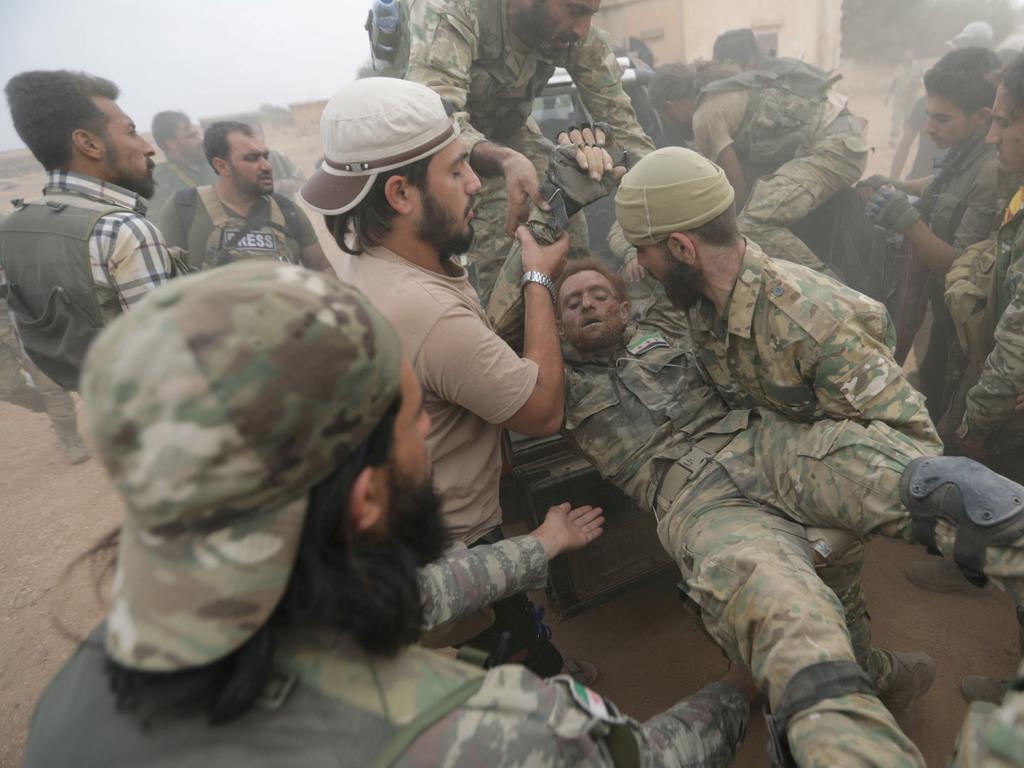


To join the conversation, please log in. Don't have an account? Register
Join the conversation, you are commenting as Logout